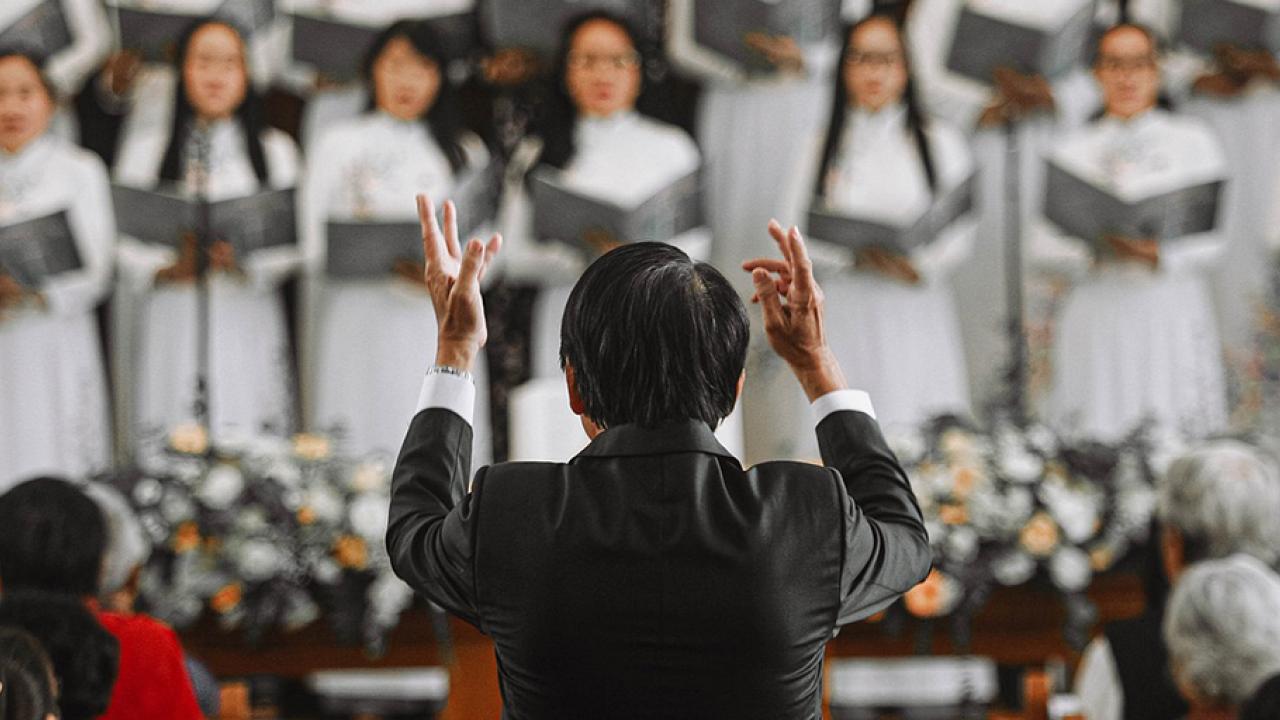If you are a choir director, you are probably working on finalizing your choral repertoire for Advent. In this blog Dr. Kai Ton Chau provides suggestions for five Advent choral pieces chosen with the smaller church choir in mind. The pieces were chosen with themes of waiting, preparation, and light, making them very adaptable for various Advent preaching series and lectionaries. Chau also included helpful teaching notes for each piece.
Advent is a time in the Christian calendar that emphasizes waiting, anticipating, preparation, the promise of Jesus’ coming (and second coming), and light. The following choral music selections are chosen around these themes and are manageable by smaller singing ensembles.
If your church choir has limited singers and/or limited time to practice (that’s many of us!), consider using the same song (or with different voice combinations) at the time of lighting the candle at each week of Advent. For example, sing “Come, Lord Jesus, Prince of Peace” or “We Are Waiting” as the candle is lit during the season. Or, if the theme of the song fits well with the sermon series. use “Wild and Lone the Prophet’s Voice” as a response to the Word preached or as a charge at dismissal.
All of the songs chosen have demonstration performances either on YouTube or on the publisher’s website. The score is available on screen so that you can determine if the lyrics and music are a good fit for your Advent theme and the ability of your choir.
"We Are Waiting"
SAB choir, piano
Words and Music: John Helgen
Arranger: Priscilla Lamparter Landis
Publisher: Augsburg Fortress, 9781506495408
YouTube: youtube.com/watch?v=yAReJwipkhE
Helgen is a published Lutheran composer and arranger. He studied theory and composition at St. Olaf College in Northfield, Minnesota, and sang with the St. Olaf Choir. “We Are Waiting” is a song of prayer with a repeating refrain of “We are waiting for Jesus; Jesus brings peace.” Therefore, it is very suitable to be used as a choral prayer at the beginning of Advent services or as a response after a prayer.
This three-part arrangement for SAB opens with unison singing for stanza 1. The refrain of the second stanza can be sung with two-part treble voices; the bass line, which acts as a pedal point on the tonic (E), is optional.
Teaching notes: Firstly, the song has a metronome marking of ♩ = 88. It is important to keep the rhythm steady throughout the piece (with a slowdown in the last seven measures). Make sure the long notes have an adequate length of time (do not rush through the long notes). Secondly, observe the dynamic markings carefully. The pickup notes of each phrase should not be accented. The first few refrains are always in mp with the stanzas in mf. The song builds toward its climatic plea, “Loving Shepherd, walk beside us; stir our hearts, and gently guide us,” and then ends with a lingering “We are waiting.”
"Come, Lord Jesus, Prince of Peace"
Unison or 2-part mixed voices and piano
Words: Barbara Davis-Pyles
Music: Frederick Frahm
Publisher: Augsburg Fortress, 9781506495255
YouTube: youtube.com/watch?v=bvfUY_Ze7ws
This Advent choral anthem for unison or 2-part mixed voices and piano is suitable for choirs of all sizes and voices. The melody throughout may be sung by the treble voice or in unison. The middle section has an optional baritone part as a counter-melody.
The melody, in B Dorian scale written in the style of an expressive art song, is paired with a poem that brings the listener to a journey from yearning (“Years in darkness, restless sleep; / starless heavens hopeless keep) to hope (“Come, Lord Jesus, Prince of peace, / break the bonds of night; / brighten ev’ry captive heart / with everlasting light.”).
Teaching notes: Pay attention to the large leaps (fifths and sixths) that happen at the beginning of the stanzas—help the singers not only attain the right pitches but also avoid sliding through the leaps. Also, take the opportunity to explain the Dorian scale (mode) if the choir has not sung this kind of music before.
"Your Light Has Come"
SAB voices and keyboard
Words: Ruth Duck
Music: John W. Becker
Publisher: GIA, G-10035
Audio recording: On the GIA page, click “PREVIEW”
Internationally renowned hymn writer Ruth Duck wrote this hymn text in 1992, echoing imagery from Isaiah 61:1–2. This hymn can be found in several contemporary hymnals including Lift Up Your Hearts (102) and Glory to God (744). In most instances, the text is paired with the hymn tune FESTAL SONG written by William H. Walter in 1894. However, Becker wrote a new, majestic, yet joyful new tune to this beloved text.
This choral anthem calls for SAB voices and a keyboard (organ or piano), making it very suitable for small church choirs. The four stanzas are set in a strophic format with a brief interlude in between them. However, each stanza has minor variations in both the melody line and the rhythm (so watch out!). Stanza 3 is sung in a canon. The harmony is tonal throughout.
This song is suitable for Advent, Christmas, and Epiphany.
Teaching notes: Notice that each stanza begins and ends with a unison note—a D at the beginning and a G at the end. This is a great opportunity to tune the choir at crucial points (especially if they practice the stanzas a cappella). The coda begins in unison and ends with spaced-out harmony. Again, encourage your singers to listen well in order to stay on pitch.
"Away in a Manger"
SAT or SATB voices and keyboard, optional assembly
Words: Adam M. L. Tice
Melody: William J. Kirkpatrick
Arranged: Chris de Silva
Publisher: GIA Music, G-10072
Audio recording: On the GIA page, click “PREVIEW”
William Kirkpatrick wrote the lovely tune, CRADLE SONG (Lift Up Your Hearts, 86b), in 1895, which pairs nicely with the hymn “Away in a Manger.” In 2009, prolific hymn writer Adam Tice rewrote the text that depicts the humanity of Joseph and Mary (stanza 2) and the mystery of incarnation (stanza 3).
This tender song opens with a brief keyboard introduction, then treble voices introduce Kirkpatrick’s melody in unison. The tenor voice joins in with “oo” in the second half of the melody. The roles are switched in the second stanza. After an interlude of “oo” (and eight measures of a cappella), stanza 3 comes in with a key change and three-part harmony. (Note: An alternate SATB version and a unison version for the congregation are also included in the sheet music.)
Teaching notes: Strive for eight-measure phrases for stanzas 1 and 2. To do so, encourage the choir to take deep (but quiet) breaths before each phrase. As for the “oos,” the phrasing is clearly marked. Practice stagger breathing at the interlude. Carefully observe the dynamic markings (especially crescendos and decrescendos) throughout the piece.
"Wild and Lone the Prophet’s Voice"
SATB and piano
Words: Carl P. Daw, Jr.
Music: Michael Larkin, incorporating the tune PLEADING SAVIOR by Joshua Leavitt (1830)
Publisher: MorningStar Music, MSM-50-0491
YouTube: youtube.com/watch?v=WNyDWFw-Z4I
Advent is a season of preparation, both for Jesus’ birth and the second coming of Christ. Using John’s prophetic voice in the desert, Carl Daw’s text encourages us to journey on until we meet the Lord. “So we dare to journey on, / led by faith through ways untrod, / till we come at last like John / to behold the Lamb of God.”
Michael Larkin sets the lyrics to the tune PLEADING SAVIOR by Joshua Leavitt written in 1830. The tune is also found in Lift Up Your Hearts (127 and 928) and Glory to God (23 and 717). Stanza 1 is sung in unison. The other stanzas are in four-part harmony. The dynamic of the song builds from mf in the beginning, to f (with key change) in the last stanza and ff at the climatic end.
Teaching notes: To keep the melody flowing, encourage your singers to breathe in four-measure phrases throughout the piece. Also, because the phrases end with three downward stepwise notes (the third phrase with four downward notes with a skip), it is important to “lift” the notes to stay in pitch and avoid “sitting on” the notes.



